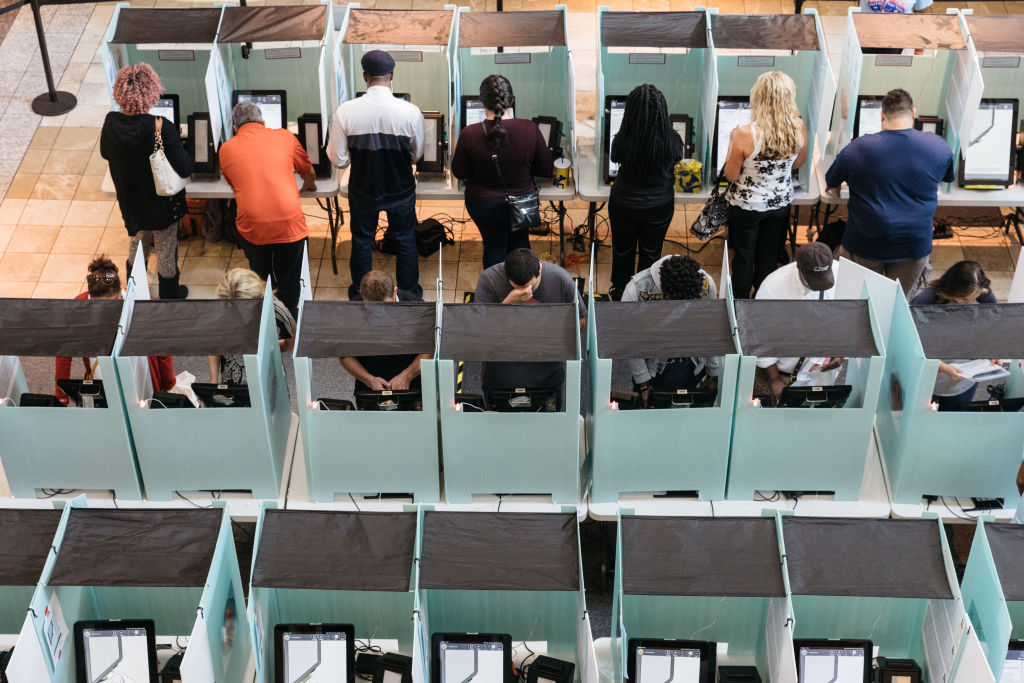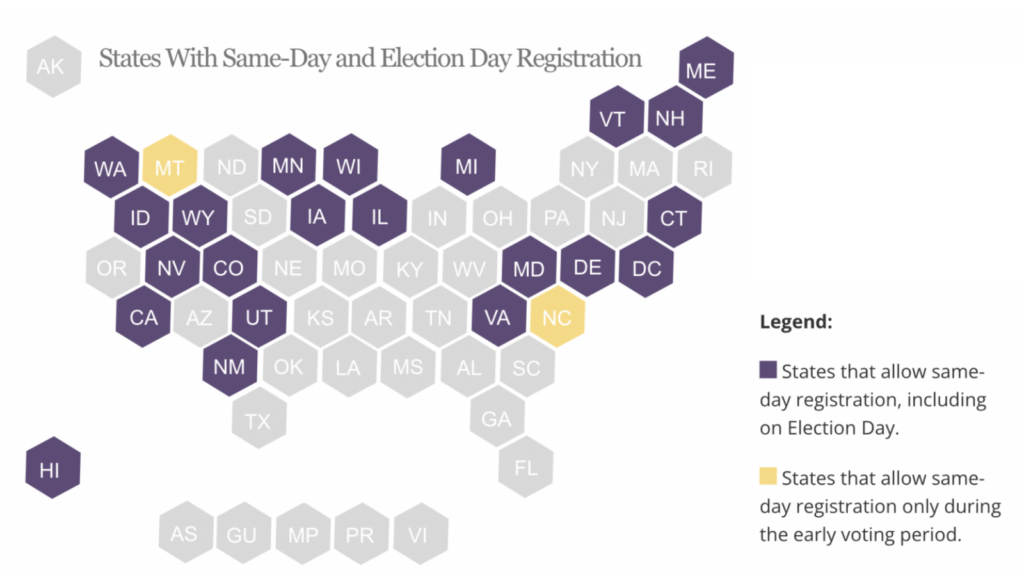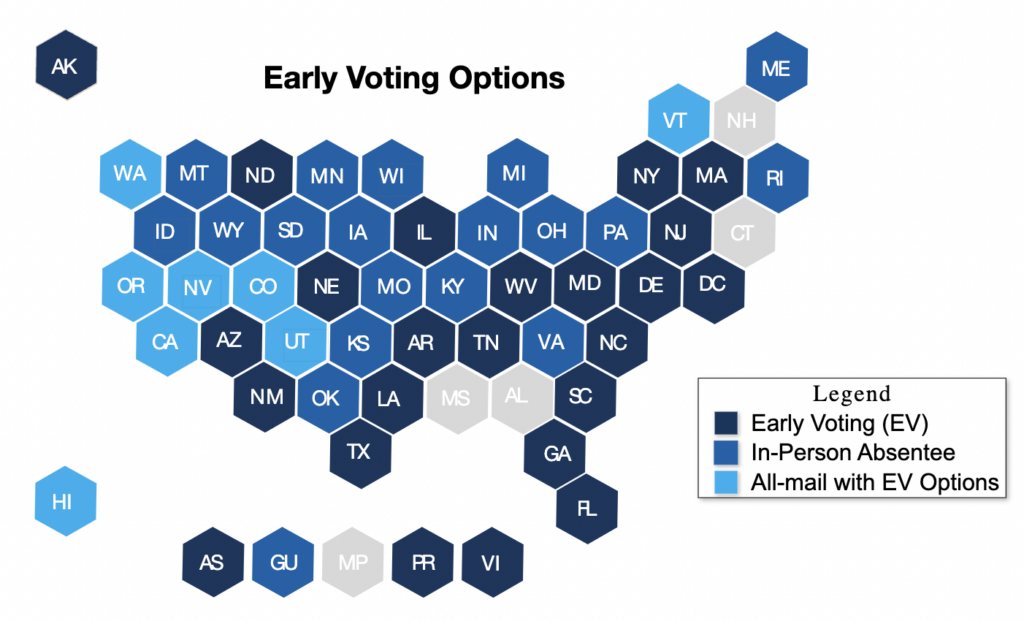
The end of national abortion protections was a wake-up call for many voters, just months before the midterms (so named because they happen in the middle of a presidential term). From candidates to key races, here’s what you need to know ahead of the upcoming elections.
This article is updated as information becomes available. Last update: Monday, Oct. 24 at 8:30 a.m. PT.
What important deadlines should I know?
Voter registration deadlines differ state by state, and many are in early to mid-October. Check your state’s deadline to register here.
State Registration Deadlines by Date
Registration deadlines are sorted by date below, according to data compiled by the Washington Post.
| Alaska | Oct. 9 |
| Rhode Island | Oct. 9 |
| Mississippi | Oct. 10 |
| Arizona | Oct. 11 |
| Arkansas | Oct. 11 |
| Florida | Oct. 11 |
| Georgia | Oct. 11 |
| Indiana | Oct. 11 |
| Kentucky | Oct. 11 |
| Ohio | Oct. 11 |
| South Carolina | Oct. 11 |
| Tennessee | Oct. 11 |
| Texas | Oct. 11 |
| Missouri | Oct. 12 |
| New York | Oct. 14 |
| Oklahoma | Oct. 14 |
| Kansas | Oct. 18 |
| Louisiana | Oct. 18 |
| New Jersey | Oct. 18 |
| Oregon | Oct. 18 |
| West Virginia | Oct. 18 |
| Alabama | Oct. 24 |
| Pennsylvania | Oct. 24 |
| South Dakota | Oct. 24 |
| Nebraska | Oct. 28 |
| Massachusetts | Oct. 29 |
| North Carolina | Nov. 5 |
| Montana | Nov. 7 |
| California | Nov. 8 |
| Colorado | Nov. 8 |
| Connecticut | Nov. 8 |
| Delaware | Nov. 8 |
| Hawaii | Nov. 8 |
| Idaho | Nov. 8 |
| Illinois | Nov. 8 |
| Iowa | Nov. 8 |
| Maine | Nov. 8 |
| Maryland | Nov. 8 |
| Michigan | Nov. 8 |
| Minnesota | Nov. 8 |
| Nevada | Nov. 8 |
| New Hampshire | Nov. 8 |
| New Mexico | Nov. 8 |
| Utah | Nov. 8 |
| Vermont | Nov. 8 |
| Virginia | Nov. 8 |
| Washington | Nov. 8 |
| District of Columbia | Nov. 8 |
| Wisconsin | Nov. 8 |
| Wyoming | Nov. 8 |
How can I check if my friends and I are registered?
Check your voter registration status here.
In total, 21 states and Washington, D.C., offer Election Day registration—meaning voters in these states can register and vote on Election Day.

Who is on the ballot?
U.S. Congress
A total of 469 seats in the U.S. Congress are up for election on Nov. 8. (See below for key races to watch.)
- The entire House of Representatives—all 435 members!—are up for reelection, as their positions are elected every two years.
- Senators serve six-year terms; about one-third of senators (34 of 100) are up for reelection.
State-Level Lawmakers
Thirty-six governors—20 Republican seats and 16 Democratic seats—are up for election or reelection this November: Alabama, Alaska, Arizona, Arkansas, California, Colorado, Connecticut, Florida, Georgia, Hawaii, Idaho, Illinois, Iowa, Kansas, Maine, Maryland, Massachusetts, Michigan, Minnesota, Nebraska, Nevada, New Hampshire, New Mexico, New York, Ohio, Oklahoma, Oregon, Pennsylvania, Rhode Island, South Carolina, South Dakota, Tennessee, Texas, Vermont, Wisconsin and Wyoming.
Twelve of these races are considered election battlegrounds, according to Ballotpedia: Alaska, Arizona, Georgia, Kansas, Maine, Massachusetts, Michigan, Minnesota, Nevada, Oregon, Pennsylvania and Wisconsin.
Where do my candidates stand on the issues?
Find nonpartisan voters guides for important 2022 races here. These guides are produced by veteran journalists with links to credible sources. They break down candidates’ stances on abortion, climate change, the economy, education, gun control, healthcare, immigration, LGBTQ rights, voting rights and more.
What are the key races to watch?
According to Malliga Och, associate professor of global studies at Idaho State University:
Democrats are hoping to flip Senate seats in Pennsylvania, North Carolina, Florida, Ohio and Wisconsin.
Republicans have set their eyes on flipping Georgia, Nevada, New Hampshire and Arizona.
Out of the nine races, Democratic incumbents are defending their seats in Arizona, Georgia, New Hampshire and Nevada—while Republicans hope to hold on to their seats in Ohio, Florida and Wisconsin.
North Carolina and Pennsylvania are the only races for open seats currently held by Republicans. Traditionally, incumbents have a strong advantage over challengers. However, the situation is different during midterms, when both parties need to overcome traditionally low turnout.
Women candidates are competing in four critical Senate races.
In Nevada, incumbent Sen. Catherine Cortez Masto (D) is defending her seat against Republican challenger Adam Laxalt.
In New Hampshire, incumbent Sen. Maggie Hassan (D) will face Republican challenger Donald C. Bolduc.
In North Carolina, Cheri Beasley, one of only two Black Democratic women nominated to run in a Senate primary in 2022, is now competing against Republican Ted Budd in a race for an open seat.
In Florida, U.S. Rep. Val Demings (D) is challenging sitting Sen. Marco Rubio (R).
What ballot measures should I know?
In the November elections, there will be five ballot measures on abortion—the most on record for any year.
- Kentucky: Constitutional Amendment 2 would amend Kentucky’s Bill of Rights to declare there is no state constitutional right to abortion.
- Montana: The Montana Born-Alive Infant Protection Act, or LR-131, asks Montanans to vote “yes” or “no” on the following statements: “Infants born alive, including infants born alive after an abortion, are legal persons,” and healthcare providers are required to “take necessary actions to preserve the life of a born-alive infant.”
- Vermont: Voters will decide on Proposal 5, the Right to Personal Reproductive Autonomy Amendment to the Vermont Constitution, which states that “an individual’s right to personal reproductive autonomy is central to the liberty and dignity to determine one’s own life course.”
- California: Proposition 1, the Right to Reproductive Freedom Amendment, would revise the California Constitution to forbid the state from interfering with or denying “an individual’s reproductive freedom … which includes their fundamental right to … have an abortion and … contraceptives.”
- Michigan: A question on the Michigan ballot asks voters whether the state should create a state constitutional right to reproductive freedom, defined as “the right to make and effectuate decisions about all matters relating to pregnancy, including but not limited to prenatal care, childbirth, postpartum care, contraception, sterilization, abortion care, miscarriage management, and infertility care.”
In Nevada, the general election ballot includes an Equal Rights Amendment that would add language to the Nevada Constitution that “prohibits the denial or abridgment of rights on account of an individual’s race, color, creed, sex, sexual orientation, gender identity or expression, age, disability, ancestry or national origin.”
As Carrie Baker wrote in the Fall 2022 issue of Ms.:
Other noteworthy ballot initiatives include minimum wage amendments in Nevada and potentially in Nebraska, a collective bargaining measure in Illinois, a right to healthcare amendment in Oregon, a Medicaid expansion initiative in South Dakota and a New Mexico amendment to direct public money to early childhood programs. Voters in five states—Alabama, Louisiana, Oregon, Tennessee and Vermont—will decide on ballot measures to repeal language from their state constitutions that allows for enslavement or servitude as punishments for crimes or, in Vermont, for the payment of debts, damages or fines.
If the Kansas primary vote is a sign, these ballot measures could expand women’s rights significantly in a number of key states.
When can I vote?
Register to vote in your state here.
There are several ways to cast your vote in the midterm elections:
In-Person on Election Day
Eligible voters in any state can vote on Election Day: Tuesday, Nov. 8.
In-Person Early Voting
Forty-six states, plus Washington, D.C., offer early in-person voting in the days and weeks before Election Day. The other four states—Alabama, Connecticut, Mississippi and New Hampshire—do not offer pre-Election Day in-person voting options for all voters.
Check your state’s in-person early voting options here.

Vote by Mail
You can also vote by mail in most states. In this case, you’d return your ballot via mail or in a secure dropbox.
- In total, 27 states plus Washington, D.C., offer “no-excuse” absentee voting. This means any voter can request a vote-by-mail ballot without providing a specific excuse or reason.
- In 8 of these states—California, Colorado, Hawaii, Nevada, Oregon, Utah, Vermont and Washington—voters will automatically receive a vote-by-mail ballot.
How do I find my polling place?
Use this tool to find a convenient polling place for you or your friends.
What issues are top-of-mind for voters?
Among young women voters ages 18-29 in the battleground states, abortion and women’s rights are the most important and highly motivating issues in determining their vote, according to new Ms. magazine and Feminist Majority Foundation (FMF) polling by Lake Research Partners across the nine battleground states of Arizona, Florida, Georgia, Nevada, New Hampshire, North Carolina, Ohio, Pennsylvania and Wisconsin.

Among women voters of all ages in the battleground states, abortion and women’s rights are tied with inflation and rising prices in determining their votes, according to the Ms. and FMF poll of all women voters.

How can I help with the elections?
Around the country, there is a need for more poll workers. Help staff your local polling place here.
Up next:
U.S. democracy is at a dangerous inflection point—from the demise of abortion rights, to a lack of pay equity and parental leave, to skyrocketing maternal mortality, and attacks on trans health. Left unchecked, these crises will lead to wider gaps in political participation and representation. For 50 years, Ms. has been forging feminist journalism—reporting, rebelling and truth-telling from the front-lines, championing the Equal Rights Amendment, and centering the stories of those most impacted. With all that’s at stake for equality, we are redoubling our commitment for the next 50 years. In turn, we need your help, Support Ms. today with a donation—any amount that is meaningful to you. For as little as $5 each month, you’ll receive the print magazine along with our e-newsletters, action alerts, and invitations to Ms. Studios events and podcasts. We are grateful for your loyalty and ferocity.





